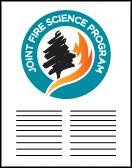United States Joint Fire Science Program
Document Type
Article
Date of this Version
2012
Citation
Final Report: JFSP Project Number Project 1497-NR01-454
Abstract
In the last decade, piñon-juniper (Pinus edulis-Juniperus osteosperma) woodlands of southwestern Colorado have been heavily impacted by wildfires and insects, and the effects on fuel structures and future fire intervals have been unclear. In these piñon-juniper woodlands, pre-historic fire rotations of up to 400 years were documented, but in recent climatic conditions, large stand-replacing wildfires burned between 1989 and 2008. Since the 1990s, a period of drought and rising temperatures, portions of the post-fire landscape were targets for invasive Carduus nutans, muskthistle and Bromus tectorum, cheatgrass, whose presence create unprecedented fuels, may shorten fire intervals, and reduce native biodiversity. We predicted that extensive tree mortality would alter fuel properties and fire behavior in dense unburned woodlands. In his two-year study, we addressed changes in fuel structures due to recent fires and insect infestations and explored management implications of these changes in Mesa Verde National Park and adjacent portions of the Ute Mountain Ute Tribal land. Given the widespread nature of the mortality event of 2002-2004 we found few unaltered woodlands to serve as undisturbed controls. Therefore, also we re-evaluated nine fuel profiles originally sampled in 1993-1995 to provide pre-mortality fuel conditions. Woodland canopy and horizontal continuity of crown fuel has been significantly reduced. We found an increase in litter, 1to 100 hr fuels, and 1000 hr fuels following the mortality event. Woodland structural diversity as has decreased. However, the structure of post-mortality woodlands remains within the historic range of variability (HRV) for this region. Fire behavior has not changed significantly except for increased heat release. In contrast, fuel structures and predicted fire behavior vary significantly across a time-since-fire chronosequence. Higher spread rate and intensity values are modeled in mid-successional areas, but measures decline as piñon-juniper woodlands get older and are lowest in old-growth stands. Early successional stages (i.e. burns in last 25 years) support Bromus tectorum, cheatgrass, which presents unprecedented levels of continuous surface fuel. Post-fire mitigation sponsored by the Federal BAER program using native perennial grasses in 1996 and 2000 significantly reduced the abundance and cover of invasive plant species which will likely have a significant effect on frequency of future fires. Native species diversity and abundance were not reduced by post-fire mitigation, nor do we detect any changes in fire behavior due to the introduction of perennial grasses. Management implications of these trends are discussed in the final section of this report.
Included in
Forest Biology Commons, Forest Management Commons, Natural Resources and Conservation Commons, Natural Resources Management and Policy Commons, Other Environmental Sciences Commons, Other Forestry and Forest Sciences Commons, Sustainability Commons, Wood Science and Pulp, Paper Technology Commons



Comments
US government work.